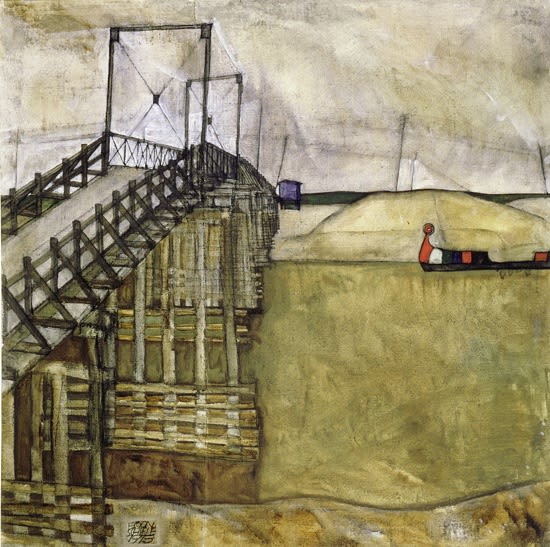“Egon Schiele: Living Landscapes” will investigate the importance of landscape in the Austrian artist’s work. Plants, natural environments, and townscapes determine the spaces Egon Schiele created in his paintings, and they also reflect the rich symbolism he employed that is centered around the human condition. In particular, plants are often endowed with an allegorical meaning. Flowers and trees assume the role of portrait subjects and convey an almost human appearance. Schiele’s landscapes always represent more than their apparent subject matter. His portrayal of nature and his rendering of towns and trees epitomize the life cycle and the human condition.
Schiele is arguably best known for his portraits, but he was also a gifted landscape painter. Even while a child, Schiele was a keen recorder of nature. As an adult, the Expressionist artist frequently sought escape from the pressures of life in Vienna, and found relief in rural surroundings. Beginning in the summer of 1910, Schiele made several trips to Krumau (today Český Krumlov, Czech Republic), his mother’s birthplace in Bohemia on the Moldau River (now Vltava River). Schiele gravitated toward highpoints on the outskirts of town where he could look down and have a bird’s-eye-view of the city and its inhabitants.
His rapturous painting, Town among Greenery (The Old City III), one of the masterworks presented in the exhibition, is depicted from such a vantage point. While the exact location of this scene is unclear, it most likely represents an imaginative and composite creation based upon Schiele’s study of Krumau and its environs. Here, the city is sandwiched between dense and verdant clusters of trees. Uncharacteristically, Schiele has even populated the vibrantly hued streets with figures immersed in the details of daily life. Krumau, a picturesque medieval town with distinctive interlocking buildings and historic structures captivated him. He also collected postcards of Krumau, which became a part of his creative process.
On occasion, Schiele shifted his lens from a macro to a micro view, and focused his attention on singular plants and trees. Sunflowers were among his favorite motifs. He painted them in all stages of life — in full bloom to brown and withering. It is easy to imagine that his intention was to imbue these flowers with anthropomorphic characteristics. Schiele may well have been inspired by the example of Vincent van Gogh, whose work was shown in Vienna during Schiele’s lifetime, including in both 1906 and 1909.
Schiele also found resonance in emotive portraits of trees. Such pictures capture the desolate quality of late autumn, especially his series of spindly and seemingly lifeless trees. Schiele offered his personal impression of this shift between seasons: “I often cried with half-opened eyes when autumn came.” Such words are even more poignant given that Schiele died on October 31, 1918, just days after his pregnant wife Edith passed away herself. They were both victims of the influenza pandemic.
Schiele’s landscapes are imbued with an existential message about the human condition. The hope and promise of spring and summer give way to decay and death before the cycle renews again. Hence, these luminous paintings are emblematic of life itself and carry universal implications.
“Egon Schiele: Living Landscapes” is organized by Neue Galerie New York. This exhibition is curated by Dr. Christian Bauer, Curator at the Egon Schiele Museum Tulln, and formerly the founding director of the State Gallery of Lower Austria in Krems. A specialist on Egon Schiele, Bauer has written numerous essays on the artist and edited books on him as well, including Egon Schiele: The Beginning (2013) and Egon Schiele: Almost a Lifetime (2015). William Loccisano is the designer of the exhibition and catalogue.
The exhibition is made possible in part by the Neue Galerie President’s Circle, Swarovski, and Withersworldwide.
- Exhibition Website
- Press: "Egon Schiele’s Hidden Obsessions Laid Bare," by Deborah Solomon, The New York Times
- Press: "Egon Schiele died young. His landscapes are forever old." by Philip Kennicott, The Washington Post
- Press: "Schiele’s living dead," by James Panero, The New Criterion
- Press: "How Egon Schiele saw the world," by Lauren Kane, Apollo Magazine
